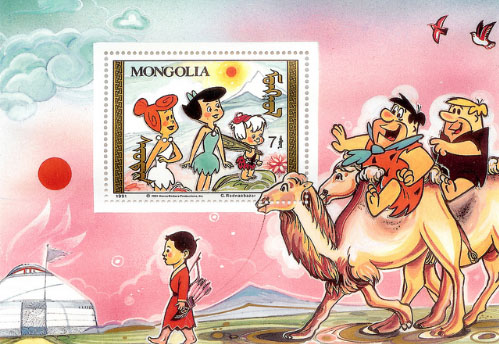
Flintstone Stamps. In February 1991, Mongolia issued a series of commemorative stamps featuring The Flintstones to generate income through sales to people who would buy them but never use them. Mongolian artists, using Hanna-Barbera model sheets, designed the images. One stamp showed a race between Pebbles riding a dinosaur next to a Mongolian child aboard a camel. Another featured Fred and Wilma and Barney and Betty cruising under a desert moon.
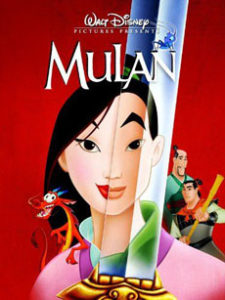 Pam Coats on Mulan. In The Boston Sunday Globe June 14, 1998, Mulan (1998) producer Pam Coats said, “I refer to both the visual design and the story with term ‘Poetic Simplicity’. Not that we sat there at the beginning and said, ‘OK, we’re going to make a poetically simple movie’. We just tried to figure out how we could have the strongest story. Originally we had a lot more the villain, a lot more of Mushu, a lot more romance. Slowly, but surely, all of those things didn’t stack up to what what happening in the movie. They became untrue to themselves and we took them out. It might have been a great idea but if it didn’t work for the movie, it went away so we ended up with this polished piece.
Pam Coats on Mulan. In The Boston Sunday Globe June 14, 1998, Mulan (1998) producer Pam Coats said, “I refer to both the visual design and the story with term ‘Poetic Simplicity’. Not that we sat there at the beginning and said, ‘OK, we’re going to make a poetically simple movie’. We just tried to figure out how we could have the strongest story. Originally we had a lot more the villain, a lot more of Mushu, a lot more romance. Slowly, but surely, all of those things didn’t stack up to what what happening in the movie. They became untrue to themselves and we took them out. It might have been a great idea but if it didn’t work for the movie, it went away so we ended up with this polished piece.
“The character of Mulan is probably the most successful aspect of the film. She’s not only endearing, she’s resourceful and heroic and she doesn’t need a man. I think she celebrates the importance of the individual. She shows what a difference one person can make.
“We hired Taiwanese artist Chen-Yi Chang to design the film’s characters and to be a culturally correct sounding board. He was our in-house Chinese expert in terms of accurate depictions. We checked with him a lot to make sure we were doing the right thing. Plus we have a lot of Asian-American animators and artists who worked on the movie.
“We made a decision very early on to cast the majority of principal roles with Asian-Americans for a couple of different reasons. The first one being that any inherent understanding of the culture that would come through casting Asian-Americans would always be helpful. And then, some of the actors have an interesting rhythm to their delivery, which I think aids the flavor of their character. So we did it for almost selfish reaons: we wanted their background to help us create as believable an environment as we could.
“We won’t make everyone happy. I don’t believe it’s possible in life to make everyone happy. But it was important for us to bring honor to a legend that so many people love so much.
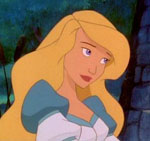 Richard Rich. In the Dallas Morning News in 1998 for the release of the third Swan Princess animated feature (The Swan Princess: The Mystery of the Enchanted Kingdom), director Richard Rich said, “I was just the lucky one. I was lifted from the Disney mailroom where I gave piano lessons in my spare time to be named director on The Fox and the Hound (1981) and assistant director on other films.
Richard Rich. In the Dallas Morning News in 1998 for the release of the third Swan Princess animated feature (The Swan Princess: The Mystery of the Enchanted Kingdom), director Richard Rich said, “I was just the lucky one. I was lifted from the Disney mailroom where I gave piano lessons in my spare time to be named director on The Fox and the Hound (1981) and assistant director on other films.
“However, my work on those Disney classics was just preparation for the work I do with Nest Entertainment on the Bible oriented videos. I believe these videos will affect more lives than anything I ever did at Disney or anything Disney will ever do. To create change, to make people better and their relationships with other people better is what’s important, because as we go through life, that’s what we should be doing – helping others.
“I’ve been real lucky with Disney and Nest . I’ve never had anything I couldn’t bring home to my six children.”
 Lois Lane Talks. In the Chicago Tribune October 10, 1996, actress Dana Delaney who was voicing the character of Lois Lane in the WB Superman animated series said, “The (Superman) scripts I get every week are better than most of the feature films scripts I get. It’s so hard to find a good role as a woman. When I read the script I knew I wanted to play Lois Lane. She’s like (actress) Rosalind Russell in His Girl Friday (1940) and that’s how I play her – smart and sassy.”
Lois Lane Talks. In the Chicago Tribune October 10, 1996, actress Dana Delaney who was voicing the character of Lois Lane in the WB Superman animated series said, “The (Superman) scripts I get every week are better than most of the feature films scripts I get. It’s so hard to find a good role as a woman. When I read the script I knew I wanted to play Lois Lane. She’s like (actress) Rosalind Russell in His Girl Friday (1940) and that’s how I play her – smart and sassy.”
 Woody and Antz. In the Dallas Morning News in October 3,1998, Tim Johnson, co-director of Dreamworks Antz (1998) said, “In computer animation, we have to be careful about the kinds of decisions we make because what may seem like a simple decision – we need a pile of rubble behind the characters in this shot – can send people off working on it for several weeks. Sometimes you have to ignore the technology in order to get the best out of technology. If there’s any message from our film, it’s be happy you’re a mammal. Life is very hard on insects.
Woody and Antz. In the Dallas Morning News in October 3,1998, Tim Johnson, co-director of Dreamworks Antz (1998) said, “In computer animation, we have to be careful about the kinds of decisions we make because what may seem like a simple decision – we need a pile of rubble behind the characters in this shot – can send people off working on it for several weeks. Sometimes you have to ignore the technology in order to get the best out of technology. If there’s any message from our film, it’s be happy you’re a mammal. Life is very hard on insects.
“Jeffrey (Katzenberg) loved the idea of using a Woody Allen character. It seemed so true to the core and he knew Woody well. So Jeffrey approached Woody and two years ago we took a bunch of artwork to him and showed him a piece of animation where we had taken an insect character speaking lines from (his film) Bananas (1971) and he asked, ‘How did you get me in there?’ He was just really intrigued and said, ‘I’ll do it. I like your story’. Jeffrey had ambitions to change animation, to challenge audiences.”
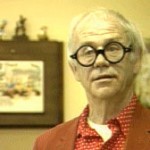 Kimball Memories. In 1996, I spent some time with Ward Kimball at the Disney Institute in Orlando, Florida where I was a salaried animation instructor. He told me that many people at the Disney Studio felt he was descrecrating the Disney heritage when he did the Mouse Factory television series in 1972. He was most regretful that Wilfred Jackson felt that way since Kimball said he respected Jackson.
Kimball Memories. In 1996, I spent some time with Ward Kimball at the Disney Institute in Orlando, Florida where I was a salaried animation instructor. He told me that many people at the Disney Studio felt he was descrecrating the Disney heritage when he did the Mouse Factory television series in 1972. He was most regretful that Wilfred Jackson felt that way since Kimball said he respected Jackson.
Ward said he had a lot of fun doing he series and had to get his Director’s Guild card to do so but never voted in any Academy Awards. In fact, he told me he never voted in any elections since Upton Sinclair ran (1934) because he felt it was useless to vote after seeing all the corruption from whomever was eventually elected.
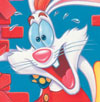 Where They Got Their Inspiration. What cartoons were shown and studied by the animators who worked on Who Framed Roger Rabbit (1988)? Smile, Darn Ya, Smile (1931), Bedtime (1923), The Fresh Lobster (1928), You Oughta Be In Pictures (1940), Anchor’s Aweigh (1945) the sequence with Gene Kelly and Jerry Mouse, Down the Drain (1946), Hot Stogie (1946), Song of the South (1946) the Zip-a-Dee-Doo-Dah and How Do You Do sequences, Midnight Snack (1941), Swing Swift Cinderella (1945), Dumb Hounded (1943), Bell Boy Donald (1942), Booby Traps (1944) and Drooler’s Delight (1949).
Where They Got Their Inspiration. What cartoons were shown and studied by the animators who worked on Who Framed Roger Rabbit (1988)? Smile, Darn Ya, Smile (1931), Bedtime (1923), The Fresh Lobster (1928), You Oughta Be In Pictures (1940), Anchor’s Aweigh (1945) the sequence with Gene Kelly and Jerry Mouse, Down the Drain (1946), Hot Stogie (1946), Song of the South (1946) the Zip-a-Dee-Doo-Dah and How Do You Do sequences, Midnight Snack (1941), Swing Swift Cinderella (1945), Dumb Hounded (1943), Bell Boy Donald (1942), Booby Traps (1944) and Drooler’s Delight (1949).


 Jim Korkis is an internationally respected animation historian who in recent years has devoted his attention to the many worlds of Disney. He was a columnist for a variety of animation magazines. With his former writing partner, John Cawley, he authored several animation related books including The Encyclopedia of Cartoon Superstars, How to Create Animation, Cartoon Confidential and Get Animated’s Animation Art Buyer’s Guide. He taught animation classes at the Disney Institute in Florida as well as instructing classes on acting and animation history for Disney Feature Animation: Florida.
Jim Korkis is an internationally respected animation historian who in recent years has devoted his attention to the many worlds of Disney. He was a columnist for a variety of animation magazines. With his former writing partner, John Cawley, he authored several animation related books including The Encyclopedia of Cartoon Superstars, How to Create Animation, Cartoon Confidential and Get Animated’s Animation Art Buyer’s Guide. He taught animation classes at the Disney Institute in Florida as well as instructing classes on acting and animation history for Disney Feature Animation: Florida.




















































Less talk about the Mulan remake, the better.
The lyrics of “Smile, Darn Ya, Smile” are a little unclear. What’s the line after “Things are never black as they are painted”?
“Time for you and joy to get acquainted!”
Found these lyrics on another site:
Smile, darn ya, smile
You know this great world is a good world after all
Smile, darn ya, smile
And right away watch lady luck pay you a call
Things are never black as they are painted
Time for you and joy to get acquainted
So make life worthwhile
Come on and smile, darn ya, smile
Lyrics:
Smile, darn ya, smile
You know this old world is a great world after all
Smile, darn ya, smile
And right away watch Lady Luck pay you a call
Things are never black as they are painted
Time for you and joy to get acquainted
Make life worthwhile
Come on and smile, darn ya, smile
Smile, darn ya, smile
For there is nothing that you cannot overcome
Smile, darn ya, smile
And where the clouds appear you soon will find the sun
Life is really only what you make it
Stand right up and show them you can take it
Make life worthwhile
Come on and smile, darn ya, smile
According to this site:
https://lyricsplayground.com/alpha/songs/s/smiledarnyasmile.html
the full lyrics are
Smile, darn ya, smile
You know this great world is a good world after all
Smile, darn ya, smile
And right away watch lady luck pay you a call
Things are never black as they are painted
Time for you and joy to get acquainted
So make life worthwhile
Come on and smile, darn ya, smile
Bob
Smile, darn ya, smile
You know this great world is a good world after all
Smile, darn ya, smile
And right away watch lady luck pay you a call
Things are never black as they are painted
Time for you and joy to get acquainted
So make life worthwhile
Come on and smile, darn ya, smile
Songwriters: Charles O’flynn / Jack Meskill / Max Rich
Smile, Darn Ya, Smile lyrics © Warner/Chappell Music, Inc
I thought The Mouse Factory was a rather great little show when I saw it as a kid back in 1972. And it whetted my appetite to see more of the old Disney cartoons. Too bad some of the Disney people didn’t like it.
“Down the Drain (1946), Hot Stogie (1946)”
That’s the first I’ve heard of these two. A Google search brought up nothing on them, so does anyone else here know of them? Are they misnamed short cartoons, or industrial/ad films, or something else I’m not thinking of.
Perhaps they were re-titled for home movie versions or overseas use.
If they’re from 1946, “Down the Drain” HAS to be Bathing Buddies. Not sure about “Hot Stogie” (Bacall to Arms?).
The Hot Stogie and Down The Drain were not home movies, but pilot cartoons that Hugh Harman produced. He made them to demonstrate a new form of optical printing to combine animation with live action. Down The Drain was a plumbing picture, ran about five minutes and featured a big fat live actor, taking a bath with hundreds of animated soap bubbles. The main animated character was a little cat who was a plumber, voiced by Harry Lang. The Hot Stogie was a very short piece, less than two minutes, which showed a live action hobo picking up an animated cigar, as I recall. The Roger Rabbit crew studied these films to get a sense of unusual live/animated films made during the golden age of American animation.
So where can we see these? Steve Stanchfield needs to put these on disc for us! (Well… hmmmm, maybe he doesn’t — he’s got an awful lot to do already!)
They should have put them on a Roger Rabbit disc!
I fondly remember The Swan Princess. “Far Longer Than Forever” was nominated for a Golden Globe. Richard Rich is an underrated animator with a distinct style if you watch his other stuff (Black Cauldron, etc.)
Those Flintstone stamps look pretty neat.
I like how they drew them from the model sheets.